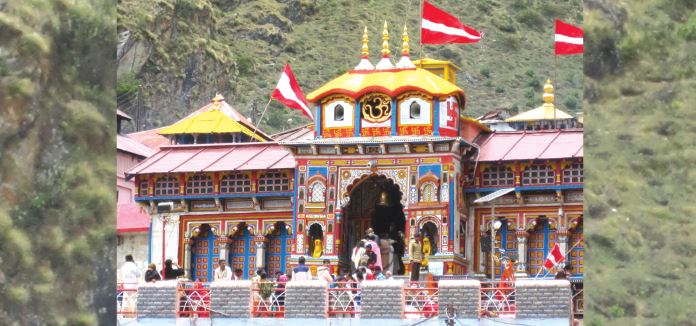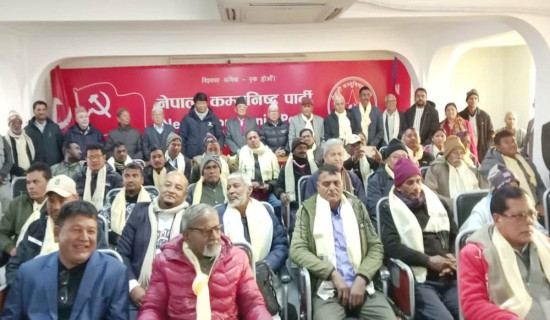- Saturday, 27 December 2025
An Unforgettable Pilgrimage
Gandhi Raj Kafle
Nepal And India
In Nepal and in our southern neighbour, India, too, the feelings of the followers of Vedic Sanatan traditions are the same. Many Nepali Hindus go to Tirthas in India every year. Chardham Yatra is very popular these days. Besides such package tours, Nepali Hindus also love to visit separately the famous pilgrimages like Varanasi, Baidhyanathdham (Babadham), Mathura-Brindaban, and Ayodhya, Mahakumbha Snan (Kumbha holy bath), Rameshwaram, Dwarika and Jagannathpuri. These pilgrimage sites occupy a highly respected place in the heart of Nepali.
In India, many Hindus regard Nepal as an incomparably sacred land of gods and goddesses. In the holy site of Kedarnath, we found pundits with Upamanyu Gotra who said they are from Nepal, and we stood in the queue early in the morning as per their advice and felt blessed after having the Darshan of Kedarnath Baba in time. Pundits, it seems, even devotees know the holy facts about Lord Shiva related to Nepal: When we said 'we are from Nepal', a few in the crowd spontaneously said 'Nepal is a sacred and the Tapobhumi country'.
The Badrinathdham visit, however, is unforgettable for several reasons. Feeling uncomfortable with cough and cold due to the non-stop and long journey, this scribe reached a medical shop nearby for some medicines, and when an elderly shopkeeper there knew that we are from Nepal, he felt excited and immediately said 'Oh! Then, you are from Shirobhaga Desh of Lord Pashupatinath. He explained the story, the body of Lord Shiva is the Kedarnath, but the head is the Pashupatinath. The Darshan of both Dhad (body) and Shira (head) of Shiva is considered to be a boon among all Hindus, he mentioned.
Later, when we reached Nepali Dharmashala, we found a Ghimire Brahman with Kashyap Gotra at Badrinath Dham. They said they are from the Bhojpur District of Nepal.
This incident shows that Nepal and India traditionally inherit some deep religious and cultural faiths and such faiths have deepened every passing year with the pilgrimages at the either side of Nepal-India border.
Bizarre Scenario
Kedar Yatra, especially from Gaurikunda, offers bizarre experiences. Thus, it is special not because the mountain is a tall and sloppy way to reach the Kedarnath Shiva shrine is very hard to move up.
The actual bizarre scenarios greet you right at the Gaurikunda (the holy pond with the name of goddess Gauri) and you will be an eye-witness not for some time but the whole ascent and descent of the hills and mountain there. The bells of mighty mules and horses not only ring, but you also have to walk cautiously so that you could avoid dashing from these traditionally obedient creatures.
On the way, two scenes which we saw were painful. One youth at an upper point of the way had been seriously injured with kicks of a furious horse from its rear leg and the other had had his hand fractured at another point of this way from the horse. You may say such incidences are rare compared to the crowd of devotees, who in huge numbers can be seen sweating to go up to receive Darshan from Kedarnath. But this remark is one-sided because the pathetic condition the injured persons go through there to reach credible places after injury for treatment is understandably enormous.
Are horses, which carry Tirthayatris and their goods, safe and strong? The scene, we encountered, was deadly. We also kept counting along the high hills while going up — the number of dead horses reached five and our hearts filled with condolences for these docile creatures.
The story is not limited to mules and horses only, there are Dokos (they call their basket to lure customers), there are Dolis (litters) and there are also plenty of Ulinkathas (it is carried by four persons). They all move up or come down the hills together because the road is the same for them all.
The quality of the hill road to go up and come down is praiseworthy because the road is wide and most of the difficult portions of it have been eased by building rough cemented steps to avoid slipping for walkers. But how can space be enough when such a huge number of odd walkers compete to ascend or descend the mountain from this only one way?
After all, to reach the top and go to the long temple line and feel blessed to have Darshan of Bhole Baba Kedareswor is considered to be one of the supremely sacred acts of life. But the additional glimpses of life's contradictions to observe and watch along this steeply high mountain road, too, are innumerable. These direct memories and impressions, too, are an inalienable part of the Kedareswor Darshan. Let's also not forget in this context that the Kedareswor Yatra has been continuously offering new themes even for filmmakers and authors.
Branding And Packaging
The word brand or package sounds business and it does not carry true meanings of the sentiments from which we feel inspired to do Tirtha or religious worship. Yet, things in Uttarakhand Tirthas in India are there in packaged form and this arrangement has enhanced the level of convenience to the huge number of Hindu religious Tirthayatris.
The road, which lets vehicles run, is spaciously double-lane. The white lines of the road have been systematically placed for traffic safety. Both sides of the road have safe spaces and in many places, we saw even the stones and soil balls that fell from the upper slope of hills accumulated within the safety lines. This is the evidence that utmost care has been given by road constructors to avoid travel dangers.
There is a huge number of Tirthayatris (pilgrims) in this season in Uttarakhand, but the number of guest houses for them, too, is very large. The names of the guest houses, too, are thematically unique. Guest house operators have given religious names: Some names of guest houses in Haridwar are Sukhadham, Shreedhardham, Haridham, Balajidham and Ranakeshwardham etc. Such influence is not limited to Haridwar only it is there in Badrinath, Kedar, Rishikesh and many other places of Uttarakhand.
Remarkably, the government of India at the national level and the Uttarakhand government at the state level have both been working in coordination to augment the religious identity of Uttarakhand. Understandably, it seems the goal is common: Uttarakhand is the Devabhumi (the land of gods); it should be made known among Hindu devotees only with this identity.
Meanwhile, in a light vein talk, we praised our young and experienced micro-bus driver Niraj Singh for his driving skills and punctuality. He humbly accepted the praise, but said: 'For us Atithi's are gods and we try our best to deliver services to them this way.
Lessons To Learn
To a new visitor, the new things he sees in another country creates an overwhelming space to compare the things with his nation's. After all, we all had been from Nepal, so, our minds and hearts widened fully while observing the Tirthas (pilgrimage sites) of Uttarakhand in India for the good of Nepal.
Nepal and India share common values. Amidst this background, the supreme value to feeling pride in both countries is Vedic civilization. Nepal, we all love to say Tapobhumi. We regard the whole of the Himalayas range (the major portion of which is in Nepal) as the abode of Lord Shiva. There are many hills, mountains and riverside holy places of Nepal where many renowned Rishis have achieved enlightenment. This is a great spiritual identity to work for in future, if Nepal wants to make Tapobhumi known in the world.
We don't say we should copy anyone for benefit, but there is also no harm learning lessons from the good things of others. The cost-friendly and comfortable transport facilities are prerequisites for development. India, it seems, has not only realised it but has done much towards it. One proof is Uttarakhand itself because it has quality roads to connect almost all the Tirthas comfortably. If the development of religious tourism is our goal, we, too, must work fast to connect Nepal's Tapobhumis with affordable modern transport and communications facilities.
(Kafle is a former Deputy Executive Editor of this daily)
















